Scottish sea fisheries statistics 2018
Tonnage and value of all landings of sea fish and shellfish by Scottish vessels, all landings into Scotland, the rest of the UK and abroad, and the size and structure of the Scottish fishing fleet and employment on Scottish vessels.
3. Landings
3.1. Landings by Scottish vessels by species type
The one per cent increase in the real terms value of landings by Scottish vessels to £574 million between 2017 and 2018 was driven by an increase in the value of demersal species. The real terms value of demersal landings increased by seven per cent and pelagic landings remained consistent with 2017, whereas shellfish landings decreased seven per cent.
The four per cent fall in tonnage landed by Scottish vessels is attributed to falls in landings of pelagic fish and shellfish. Pelagic landings fell six per cent by tonnage and shellfish landings fell 15 per cent. Demersal landings increased six per cent.
Table 1. Change in total tonnage and value of landings by Scottish vessels between 2018 and 2017[1] [2]
| Tonnage 2018 | Change from 2017 | Value (£000) 2018 | Change from 2017 | |
|---|---|---|---|---|
| Demersal | 107,551 | 6% | 201,293 | 7% |
| Cod | 18,521 | 25% | 43,480 | 25% |
| Haddock | 29,048 | 3% | 42,556 | -1% |
| Monkfish | 12,783 | 0% | 38,675 | 5% |
| Other demersal | 47,199 | 3% | 76,583 | |
| Pelagic | 284,807 | -6% | 201,745 | 0% |
| Mackerel | 153,000 | -15% | 163,699 | -1% |
| Herring | 64,622 | 15% | 24,377 | 1% |
| Other pelagic | 67,185 | 13,669 | ||
| Shellfish | 53,243 | -15% | 170,556 | -7% |
| Nephrops | 18,178 | -16% | 62,627 | -18% |
| Scallops | 15,384 | -2% | 37,962 | -6% |
| Other shellfish | 19,681 | 69,967 | ||
| Total | 445,602 | -4% | 573,594 | 1% |
As shown in Chart 2, in 2018 pelagic species represented 64 per cent by tonnage (285 thousand tonnes) and over one third of value (£202 million). Demersal species represented nearly a quarter of the tonnage of all landings (108 thousand tonnes) and around one third of the value (£201 million). Shellfish landings accounted for 12 per cent of tonnage (53 thousand tonnes) and 30 per cent by value (£171 million). This highlights the general difference in prices: Shellfish and demersal species generally tend to attract higher prices per tonne than pelagic species.
Chart 2. Percentage of Scottish vessels' landings by species type in 2018
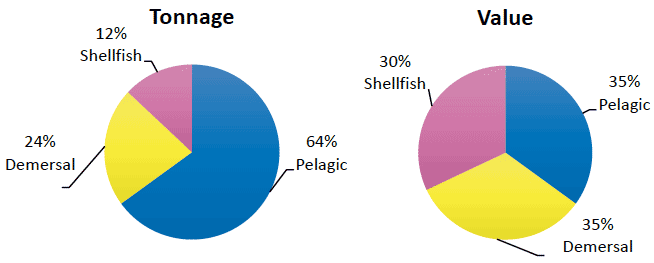
Pelagic species
The Scottish pelagic fleet comprises a small number of large vessels (19 vessels in 2018) that fish primarily for mackerel and herring. Mackerel remained the most valuable species with £164 million, accounting for 29 per cent of the total value of Scottish landings. In 2018 the real value of mackerel landings fell one per cent and tonnage decreased by 15 per cent in line with a reduction in available quota. The real terms value of herring increased by one per cent and tonnage landed increased 15 per cent since 2017.
Over the ten years 2009-2018, the tonnage of pelagic landings has increased by nearly two fifths (39 per cent) with real terms value rising by 14 per cent. The number of over 10m pelagic fishing vessels has remained broadly stable, reducing from 25 to 19 vessels (Table 37).
Demersal species
Scotland has a mixed demersal fishery which includes a dozen species with landings that are worth £1 million or more annually (Table 5). Most demersal species increased in real terms value compared to 2017 with a modest decrease in the value of haddock and ling. The real terms value of hake fell 19 per cent. The top three demersal species by value are cod, haddock and monkfish (anglerfish). Cod became the most valuable demersal species and represented eight per cent of the total value of Scottish vessels' landings and 22 per cent of the value of demersal landings in 2018. Haddock accounted for seven per cent of the value of Scottish vessels' landings and 21 per cent of demersal landings in 2018. Monkfish accounted for seven per cent of the total value of Scottish vessels' landings and 19 per cent of the value of demersal landings in 2018.
Cod landings rose in real terms value by one quarter to become the most valuable demersal species at just over £43 million. The real terms value of haddock was down one per cent to just under £43 million and monkfish rose five per cent to £39 million.
Compared to 2009, demersal landings have increased four per cent with value rising by 16 per cent. This is in spite of the over 10m demersal fleet falling by one third (91 fewer vessels).
Chart 3. Tonnage of landings by Scottish vessels by species type 2009 to 2018
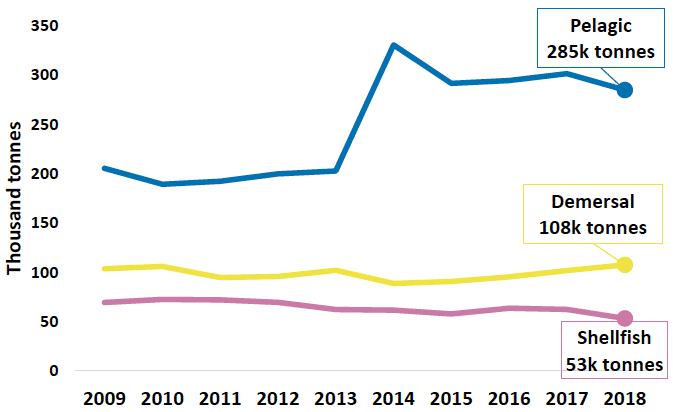
Chart 4. Real terms value of landings by Scottish vessels by species type 2009 to 2018
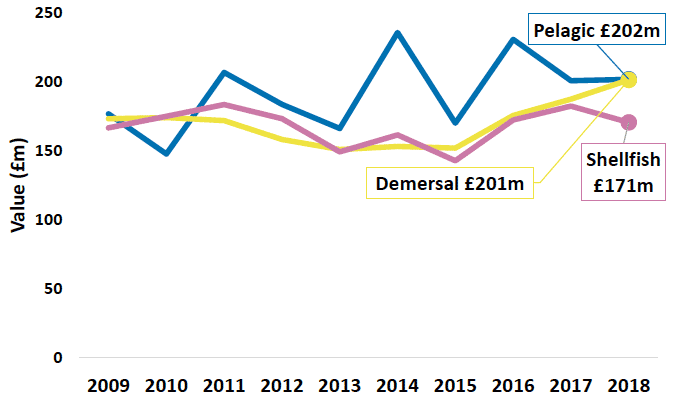
Shellfish species
Nephrops are the most valuable shellfish stock and the only shellfish species subject to quota. The Scottish fleet fish for Nephrops by creeling and by trawling. Creeled Nephrops are often caught and exported alive. Creeled Nephrops typically represent a smaller tonnage of landings attracting a price per tonne two to three times that of trawled Nephrops. The average price per tonne of creeled Nephrops was £6,865 per tonne while for trawled Nephrops the average price was £3,171 per tonne. In 2018, 1,335 tonnes of creeled Nephrops were landed by the Scottish fleet with a value of £9 million[3]. 17 thousand tonnes of trawled Nephrops were landed worth £53 million[4]. These data are presented in Table 26.
Edible crabs, velvet swim crabs and lobsters make up a small proportion of overall value landed by Scottish vessels (nine per cent combined) but are important for Scotland's large inshore fleet. Tonnage of edible crabs decreased from 2017 by 12 per cent to ten thousand tonnes and the value in real terms increased by 29 per cent to £26 million. Tonnage of lobsters remained consistent with 2017 at 1,213 tonnes and the value in real terms increased by six per cent to £19 million. The increases in value reflect high prices per tonne for shellfish, with the price per tonne of crabs rising by 46 per cent and lobsters by six per cent in real terms from 2017 to 2018.
Over the period 2009 to 2018, shellfish landings have fallen by 23 per cent while real terms value has risen two per cent, reflecting growth in shellfish prices. This is in spite of the value of Nephrops falling by one fifth over the same period. The number of over 10m shellfish vessels has fallen 12 per cent and the number of 10m and under creeling or Nephrops trawling vessels has risen three per cent.
Chart 5. Trend in tonnage of key species landed by Scottish vessels 2009 to 2018
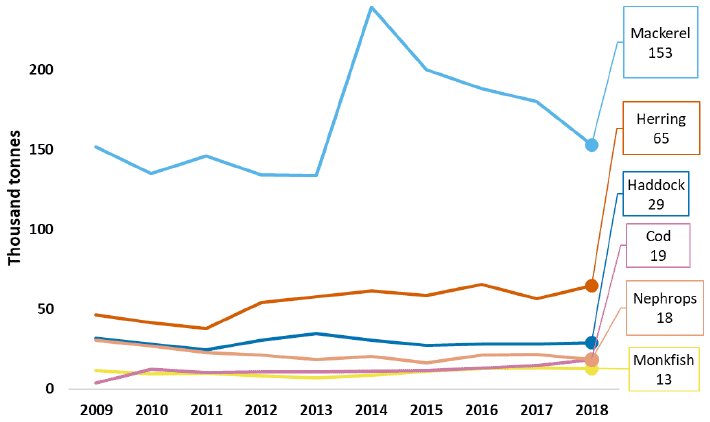
Chart 6. Trend in real value of key species (value of £20 million or over) landed by Scottish vessels 2009 to 2018
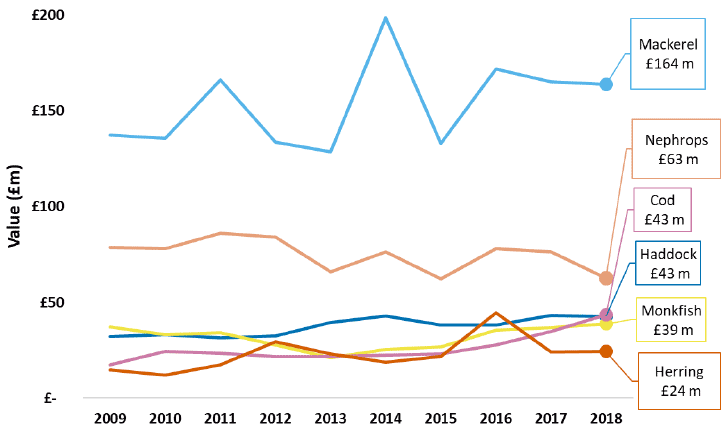
Chart 7. Real terms price per tonne for key species (value of £20 million or over landed by Scottish vessels) 2017 and 2018
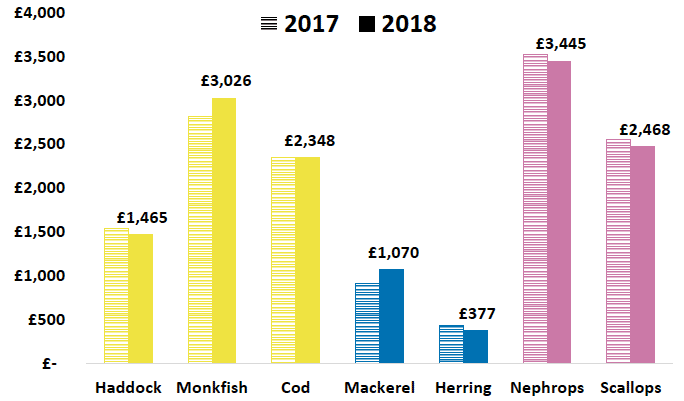
The price per tonne for each species is presented in Table 23 for the period 2014 to 2018.
3.2. Landings abroad by Scottish vessels
In 2018, Scottish vessels landed 159 thousand tonnes of sea fish and shellfish worth £122 million abroad. The tonnage landed abroad decreased by 11 per cent and the real terms value of landings abroad decreased by one per cent since 2017 (Table 4). Landings abroad accounted for 36 per cent of all landings by Scottish vessels by tonnage and 21 per cent by value. Of this, 95 per cent of the tonnage landed abroad was pelagic, four per cent was demersal and one per cent was shellfish.
The main species landed abroad was mackerel, representing 70 per cent of the total value of fish landed abroad in 2018. Since 2017, mackerel landings abroad have fallen in tonnage by 18 per cent and decreased in real terms value by one per cent. There were 78 thousand tonnes of mackerel worth £85 million landed abroad, which is 51 per cent of the total tonnage and 52 per cent the value of mackerel landed by Scottish vessels. The price for mackerel landed into the UK in 2018 was an average of £1,044 per tonne, while mackerel landed abroad received an average of £1,095 per tonne.
Norway is by far the largest destination for Scottish vessels' landings abroad, accounting for 59 per cent by tonnage and 70 per cent by value of all Scottish vessels' landings abroad. Landings into Norway fell 15 per cent by tonnage compared to 2017 and the real terms value of these landings have fallen by seven per cent (Table 25). The fall in tonnage of mackerel landings into Norway is consistent with the fall in overall tonnage of landings of mackerel by Scottish vessels. Nearly all Scottish landings into Norway were of pelagic species.
In 2018, 88 per cent of the value of landings into Norway was for mackerel, amounting to 68 thousand tonnes with a value of £74 million.
Key countries for demersal landings were the Netherlands, Spain and Denmark. Scottish vessels landed seven thousand tonnes of demersal species abroad with a value of £13 million.
Only 945 tonnes of shellfish were landed abroad by Scottish vessels in 2018, mainly into Ireland, the Netherlands and France.
Chart 8. Percentage of tonnage and value landed abroad by Scottish vessels by species type in 2018
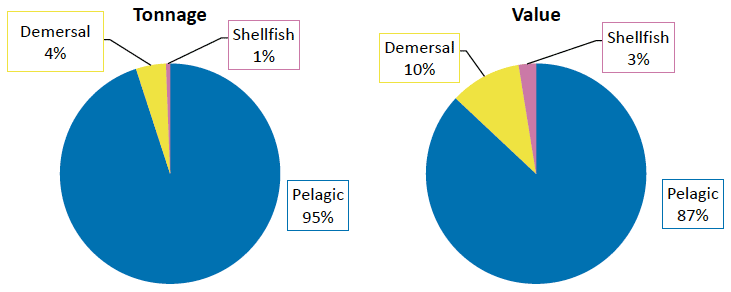
Figure 2. Tonnage landed abroad by Scottish vessels by country of landing and species type in 2018
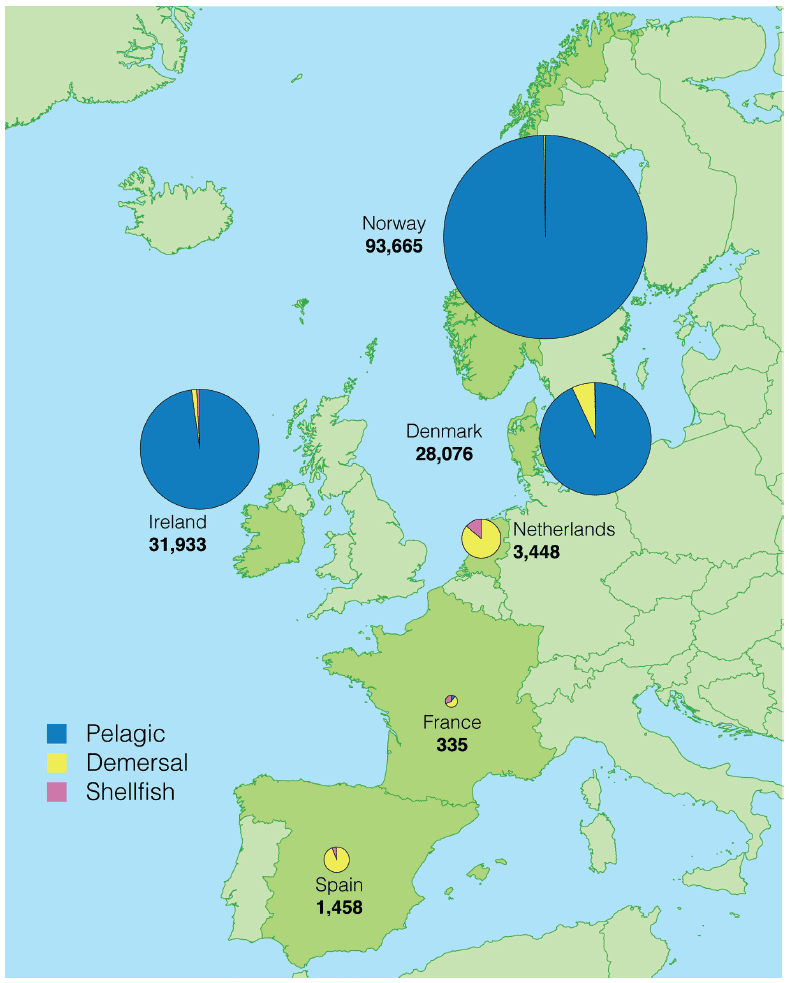
Figure 3. Value of landings (£' thousands) abroad by Scottish vessels by country of landing and species type in 2018
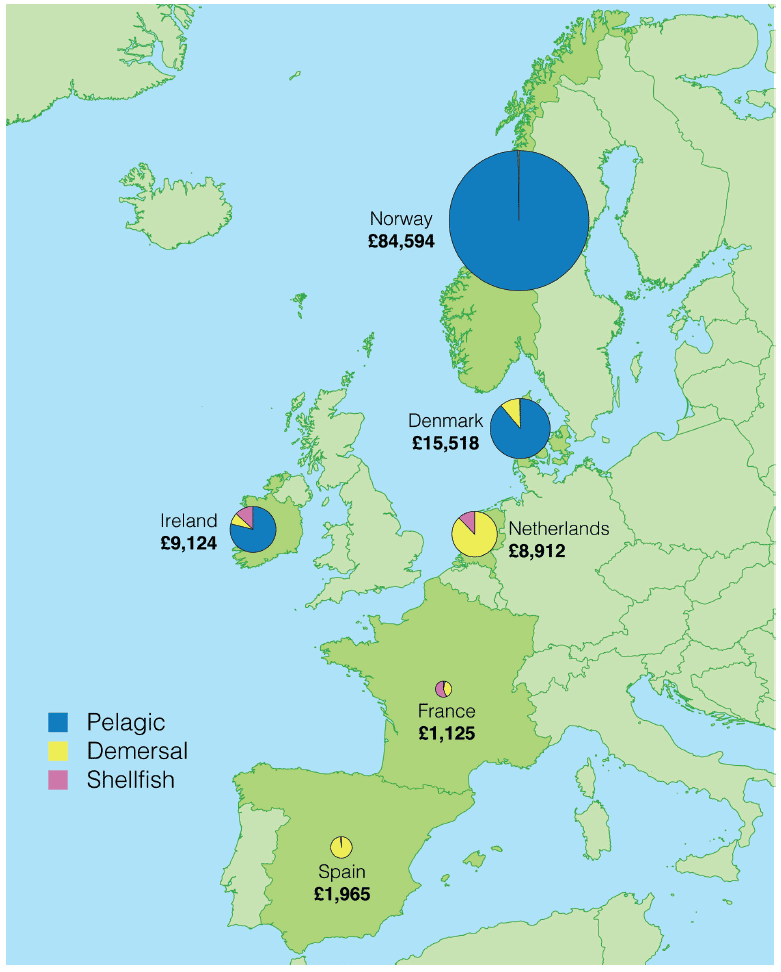
3.3. Landings by area of capture
Scottish vessels are most active in two main ICES Rectangles[5]: the Northern North Sea (ICES Area IVa) and the West Coast of Scotland (ICES Area VIa) (Figure 4 and Figure 5). 240 thousand tonnes of sea fish and shellfish with a value of £323 million were landed from the Northern North Sea, representing 54 per cent of the tonnage and 56 per cent of the value of all landings by Scottish vessels (Table 27). One quarter (25 per cent) of landings by Scottish vessels by tonnage were caught in the West Coast of Scotland (VIa), providing a little over one quarter (27 per cent) of the total value of all Scottish landings. Area VII (excluding the Irish Sea) accounted for 11 per cent of the tonnage of all landings and five per cent of value.
By species type, 74 per cent of the tonnage of all demersal landings by Scottish vessels was caught in the Northern North Sea (IVa), and 13% in the West Coast of Scotland (VIa). For pelagic landings, 51 per cent by tonnage were caught in the Northern North Sea (IVa) and 29 per cent were caught in the West Coast of Scotland (VIa).
A higher tonnage of shellfish species was caught in the West of Scotland (Area VIa) than in the Northern North Sea. The Central North Sea (ICES Area IVb) and the Irish Sea (VIIa) are also areas of considerable activity for shellfish fisheries. By tonnage, shellfish catches from the West of Scotland accounted for 32 per cent of all shellfish landings and 29 per cent of shellfish landings were caught in the Northern North Sea (IVa). 17 per cent of shellfish catches were from the Central North Sea (IVb) and seven per cent were from the Irish Sea (VIIa). Almost all landings from the Irish Sea were of shellfish species.
Further data on fishing activity in the seas around the UK by Scottish vessels, other UK vessels and foreign vessels that land into the UK are available by ICES rectangle on the Scottish Sea Fisheries Statistics website (see Annex 3). These data show the tonnage and value of landings by species type and fishing effort by ICES rectangle. Maps on fishing activity in Scottish waters by Scottish vessels, other UK vessels, and foreign vessels that land into the UK are available on the National Marine Plan Interactive (NMPi) webpage.
Figure 4. Tonnage landed by Scottish vessels by area of capture and species type in 2018
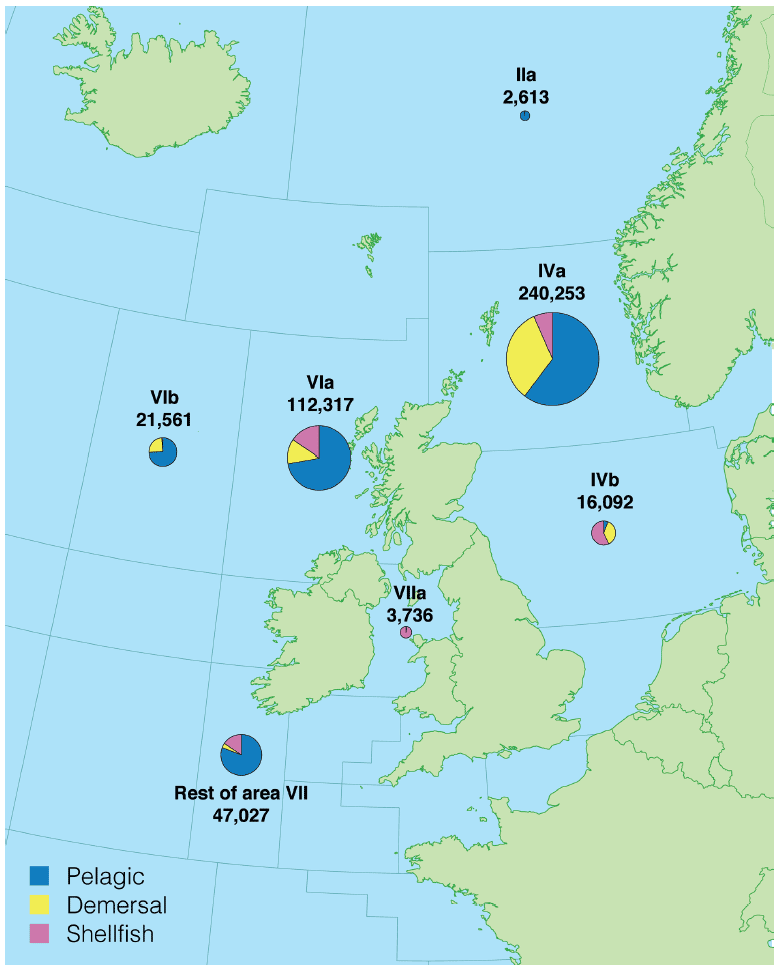
Figure 5. Value of landings (£'thousands) by Scottish vessels by area of capture and species type in 2018
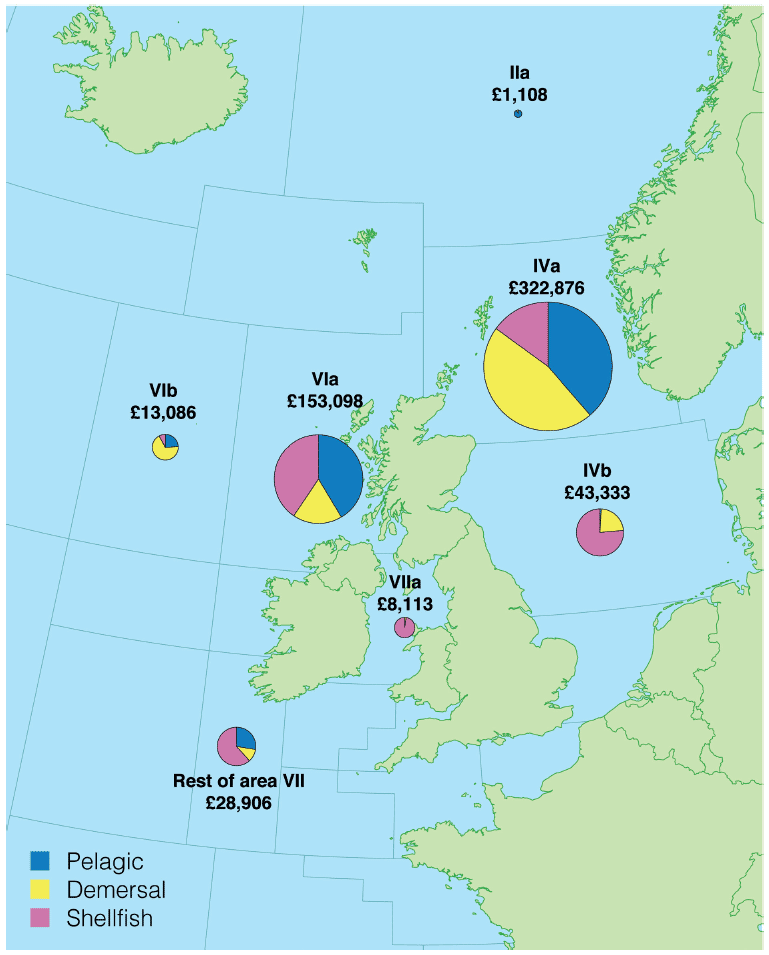
3.4. All landings into Scotland
In 2018, 349 thousand tonnes of sea fish and shellfish with a value of £521 million were landed into Scotland. This represents a two per cent increase in tonnage and one per cent in real terms value from 2017. Landings of demersal species accounted for 43 per cent, pelagic species 45 per cent and shellfish species 13 per cent of the total tonnage landed into Scotland. By value, almost half (49 per cent) of landings into Scotland were demersal species, 22 per cent were pelagic and 29 per cent were shellfish species[6]. The differences in shares by tonnage and value reflect the differences in average prices per tonne across the species types: shellfish sell at relatively higher average prices per tonne, whilst pelagic species receive the lowest average prices per tonne (Table 23).
Figure 6 and Figure 7 show landings by all vessels by species type into the eighteen Scottish port districts (also in Table 28). Landings into the south-west coast and south-east coast were dominated by shellfish, while landings into the north-west coast were mostly demersal and the north-east coast were mostly pelagic landings. The top three districts in Scotland by total tonnage landed were Peterhead (east coast), Shetland (north) and Fraserburgh (east coast). Peterhead is the single largest fishing port in the UK by tonnage and value of landings.
Combined, the top three districts for tonnage accounted for 77 per cent of total weight landed and 61 per cent of value of all landings into Scotland. Peterhead had 170 thousand tonnes landed in 2018 with a value of £184 million. This represents a four per cent increase in tonnage and a one per cent increase in real terms value from 2017. By tonnage, three-fifths (60 per cent) of the landings into Peterhead comprised pelagic species and these accounted for two-fifths (40 per cent) of the landings value into the district. In contrast, 38 per cent of the tonnage landed into Peterhead was demersal species that accounted for 55 per cent of the value.
Landings into Shetland totalled 69 thousand tonnes (up ten per cent from 2017) and were valued at £88 million (up 12 per cent). As with Peterhead, the majority of landings into Shetland by tonnage were of pelagic species, which represented 61 per cent of the total tonnage landed and 37 per cent of the total value of landings. Demersal species accounted for over one third (36 per cent) of the tonnage and over half (56 per cent) of the value landed into Shetland.
Landings into Fraserburgh totalled 28 thousand tonnes worth £44 million. The largest landings were pelagic species, which represented two-fifths (40 per cent) of the tonnage landed and 18 per cent of the total value of landings. Demersal species accounted for 38 per cent of the tonnage and value landed into Fraserburgh, with shellfish species making up 22 per cent of the tonnage and 45 per cent of the value.
The largest percentage fall in tonnage landed was into Mallaig (56 per cent fall) due to lower landings of Nephrops into the district compared to 2017. The largest percentage rise in tonnage was into Scrabster (up 18 per cent) due to increased landings of cod, haddock and saithe.
Figure 6. Tonnage landed into Scotland by all vessels by district and species type in 2018
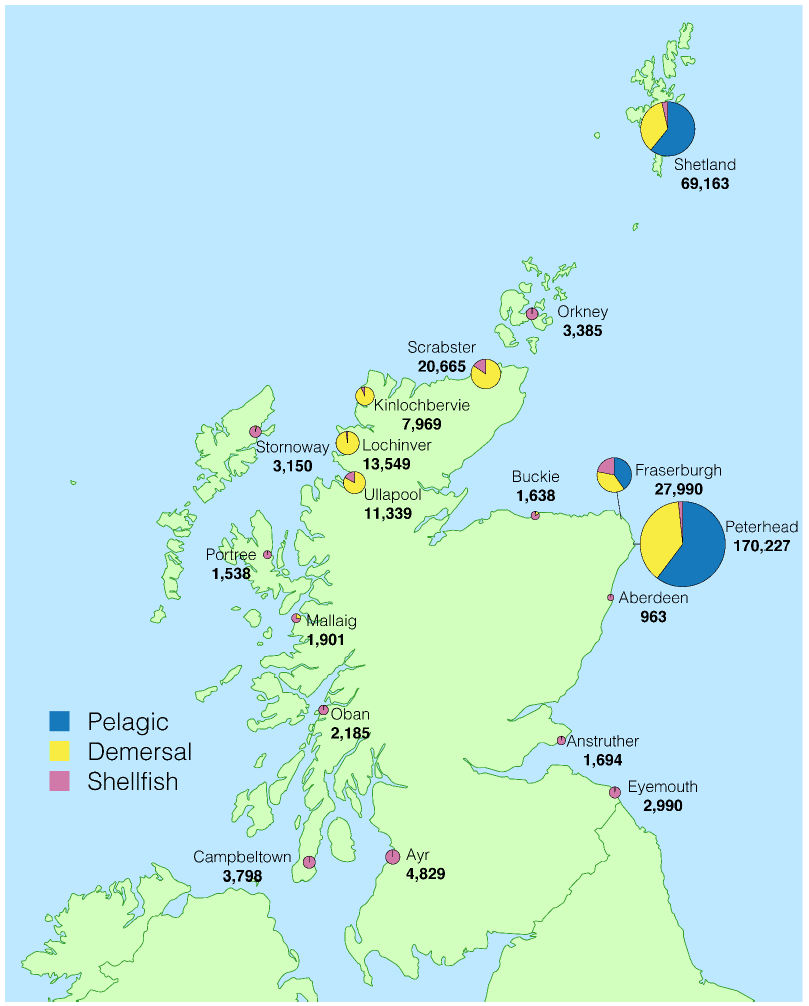
Figure 7. Value of landings (£'thousands) into Scotland by all vessels by district by species type in 2018
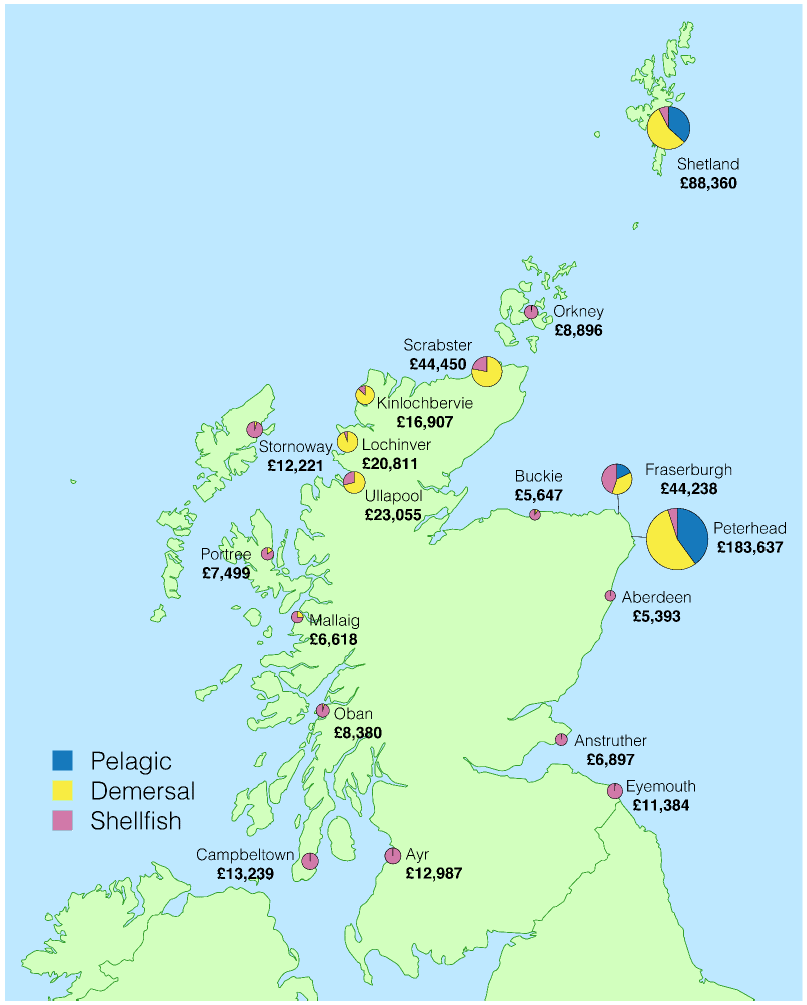
3.5. Total Allowable Catches quota and uptake
Total Allowable Catches (TAC) are limits set at annual international negotiations for individual fish stocks and represent the maximum of each fish stock that can be caught. Some stocks are managed and fished only by European Union (EU) member states. The TACs for these stocks are set by the European Commission through internal negotiations between EU member states with an interest and based on independent scientific advice from ICES. Other stocks are managed and shared with non-EU states and TACs for these are set at separate negotiations with the 'Coastal States': Norway, Iceland, the Faroe Islands and Russia. The EU TAC is shared among EU member states based on a number of factors, including each member state's past catch record. The amounts corresponding to this share, known as quotas, are shown at the UK and at the Scottish Producers Organisations' (POs) level in Table 33. Uptake of key commercial quota stocks by all Scottish vessels by tonnage and value landed are presented in Table 34.
Chart 9 compares the quota uptake of key quota stocks (with landings by Scottish vessels in excess of £20 million) for Scottish POs over the last five years in the North Sea and West Coast. In general, Scottish POs had high quota uptake in 2018 for key demersal and pelagic species. Only one stock exceeded quota: West of Scotland mackerel at 102 per cent of quota allocation.[7] West of Scotland cod has a nil quota and is managed as a bycatch.
For demersal stocks, uptake in the North Sea was generally high with cod quota uptake at 97% and haddock at 87%. Uptake of plaice, sole and megrim was lower (41 - 63%). In the West Coast, demersal uptake was slightly lower for each species than the North Sea with 80-90 per cent uptake across the top demersal species. Of the three haddock stocks, all were above 80 per cent uptake and monkfish uptake reached 74 per cent in the North Sea and 92 per cent on the West Coast.
Pelagic species have consistently high quota uptake for both the West Coast and North Sea. Mackerel quota uptake was 102 per cent for the West Coast and 99 per cent for the North Sea. This is one percentage point up on 2017 for the West Coast and one percentage point down for the North Sea. For herring, West Coast uptake was at 99 per cent and North Sea uptake was 100 per cent.
The only shellfish species subject to quota is Nephrops. In 2018, Scottish PO quota uptake for North Sea Nephrops was 52 per cent and for West Coast Nephrops it was 71 per cent. This is 34 percentage points down compared to 2017 for the North Sea no change for the West Coast.
Chart 9. Percentage quota uptakes of key commercial stocks by vessels in Scottish Producer Organisations in 2018
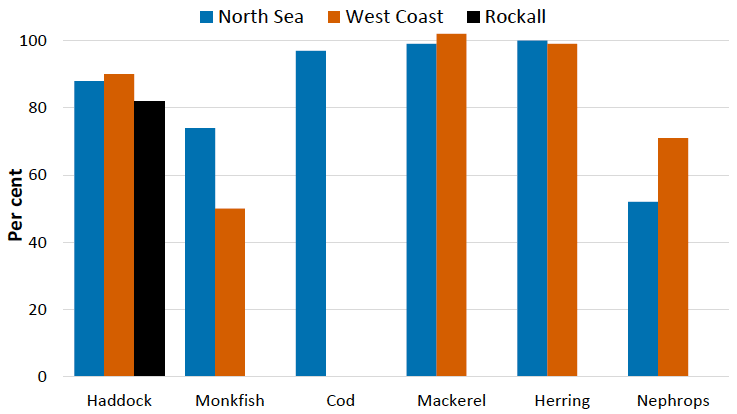
Contact
Email: Cameron.Melvin@gov.scot
There is a problem
Thanks for your feedback